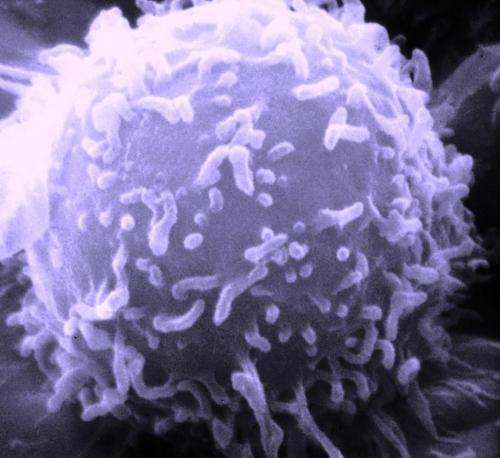Nerves keep pancreatic cancer cells from starving

Pancreatic cancer cells avert starvation by signaling to nerves, which grow into dense tumors and secrete nutrients. This is the finding of a study with experiments in cancer cells, mice, and human tissue samples published online November 2 in Cell.
The study addresses pancreatic ductal adenocarcinoma (PDAC), the deadliest cancer of the pancreas with a five-year survival rate below 10 percent. Such tumors encourage the growth of dense tissue that presses on blood vessels, reducing the supply of blood-borne nutrients like serine. This amino acid is used as a building block for proteins, and is required for cancer cells to multiply.
Led by researchers from NYU Grossman School of Medicine, the Department of Radiation Oncology at NYU Langone Health, and Perlmutter Cancer Center, the new study found that starving pancreatic cancer cells secrete a protein called nerve growth factor, which sends signals to extensions of nerve cells, instructing them to grow deeply into tumors. The researchers found further that such extensions, called axons, secrete serine, which rescues pancreatic cancer cells from starvation and restores their growth.
"Our study offers more proof that pancreatic cancers are remarkable metabolic scavengers, which contributes to their deadliness," says corresponding author Alec Kimmelman, MD, Ph.D., the Anita Steckler and Joseph Steckler Chair of the Department of Radiation Oncology at NYU Langone. "The ability of nerves to funnel nutrients from the bloodstream to the more austere pancreatic tumor microenvironment is a fascinating adaptation, and could lead to therapeutic approaches that interfere with this unique flexibility."
The study found that pancreatic cancer cells starved of serine take advantage of the process by which messenger RNA (mRNA) strands, copies of DNA instructions, are translated into proteins. Backbones of mRNA molecular strands, called bases, are decoded into amino acids using three-base units called codons. Cellular machines called ribosomes read each codon as they link amino acids together in the right order, but ribosomes stall if there is a lack of available amino acids.
Surprisingly, the research team found that serine-starved pancreatic cancer cells more significantly slow the rate at which two of the six serine codons (TCC and TCT), but not all six as assumed, are translated into amino acid chains. Under serine-starved situations, this variability lets cancer cells minimize the production of certain proteins (to preserve energy stores during starvation), but continue to build stress-adaptive proteins like nerve growth factor (NGF), which happens to be encoded by few TCC and TCT codons.
NGF and other factors are known to encourage nerves to grow into pancreatic tumors, and to increase tumor growth as well. The current study is the first to show that axons, extensions of neuronal cells that transmit their signals, provide metabolic support to cancer cells by secreting serine in nutrient-deprived areas, say the authors.
The new publication is one of many by Perlmutter researchers in recent years that describes the ways in which pancreatic cancer cells find energy. A 2016 study revealed that such cells send signals to nearby stellate cells, causing them to break down their own cell parts into building blocks that can be used by tumors. Then a December 2019 study found that pancreatic cancer cells also hijack a process called macropinocytosis, which normal cells use to pull nutrients in through their outer membranes. Interestingly, the new work found that stellate cells and macropinocytosis cannot supply enough serine for these cancer cells to grow, and that axonal delivery is required.
In a glimpse of potential future applications for the study, mice with PDAC tumors fed serine-free diets saw 50 percent slower tumor growth. To go beyond what diet alone could achieve, the researchers also blocked the recruitment of axons into PDAC tumors using a drug already approved by U.S. Food and Drug Administration called LOXO-101. The drug blocks the activation of a receptor protein on the surface of neurons that interacts with nerve growth factor (also called TRK-A), thereby inhibiting the ability of neurons to send their axons into tumors.
The drug alone did not slow PDAC tumor growth in mice, say the authors, but slowed it by an additional 50 percent when combined with a serine-free diet, compared with the diet alone. This suggests that nerves were necessary to support PDAC cell growth in serine-deprived tumor regions, researchers say.
"As TRK inhibitors are approved in the treatment of some cancers, they might have value in combination with a low serine diet following surgery in the perhaps 40 percent of patients with PDAC tumors that can't make serine," said lead study author Robert Banh, a post-doctoral scholar in Kimmelman's lab. "Whether this approach could decrease tumor recurrence by limiting the nutrient supply would need to be confirmed in clinical trials."

















